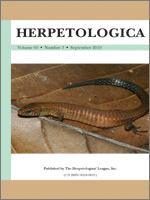We revise the taxonomic status of Desmognathus wrighti, which occurs in the southern Appalachians of western North Carolina, eastern Tennessee, and southwest Virginia, USA, based on a combination of genetic, ecological, and morphometric analyses. Previously, we reported fixed differences in allozymic loci and mitochondrial DNA sequences between lineages geographically divided by the French Broad River basin at the level of species divergence. Here, we show that these two lineages also differ in ventral pigmentation and several measures of body size, including snout–vent length, body condition, and head width. In addition, spatially explicit ecological-niche analyses of climate at more than 400 collection localities spanning the range of D. wrighti indicate that the lineages separated by the French Broad River are in unique environmental niche space. Ecological niche models resolved that population localities north of the river were generally colder and drier than localities to the south, which suggests that divergent selection pressures may exist, in addition to isolation by distance, to drive the diversification of these two lineages. The name Desmognathus wrighti (King, 1936), for which the type locality is Mt. LeConte within the Great Smoky Mountains, Tennessee, was retained for all populations south and west of the French Broad River, while the name D. organi, with type locality at Whitetop Mountain, Virginia, was given to those populations north and east of the river.
BioOne.org will be down briefly for maintenance on 17 December 2024 between 18:00-22:00 Pacific Time US. We apologize for any inconvenience.
How to translate text using browser tools
1 September 2010
Taxonomic Revision of Desmognathus wrighti (Caudata: Plethodontidae)
Erica J. Crespi,
Robert A. Browne,
Leslie J. Rissler
ACCESS THE FULL ARTICLE

Herpetologica
Vol. 66 • No. 3
September 2010
Vol. 66 • No. 3
September 2010
Desmognathus organi
Desmognathus wrighti
Ecological-niche modeling
Plethodontidae
salamanders
southern Appalachians
systematics




